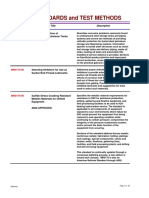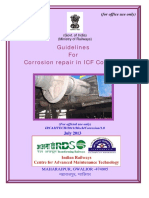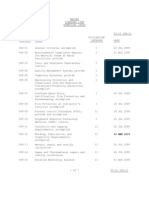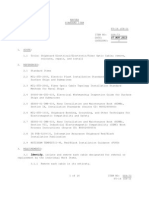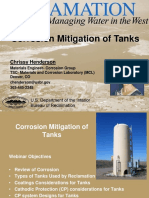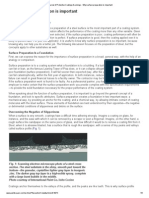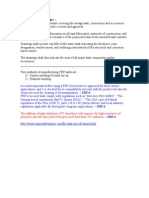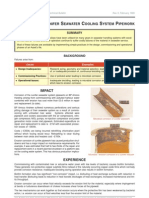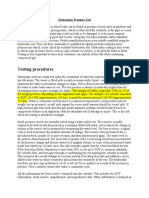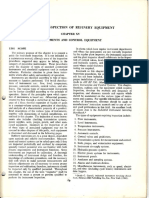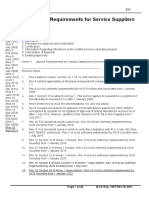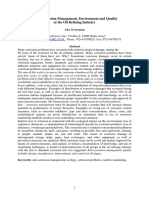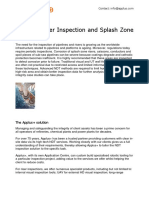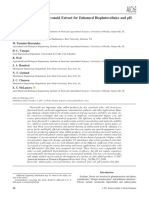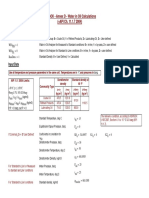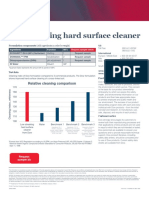Inspecting Water Tank Linings The Importance of The First Anniversary
Inspecting Water Tank Linings The Importance of The First Anniversary
Uploaded by
Izzan SabelloCopyright:
Available Formats
Inspecting Water Tank Linings The Importance of The First Anniversary
Inspecting Water Tank Linings The Importance of The First Anniversary
Uploaded by
Izzan SabelloOriginal Title
Copyright
Available Formats
Share this document
Did you find this document useful?
Is this content inappropriate?
Copyright:
Available Formats
Inspecting Water Tank Linings The Importance of The First Anniversary
Inspecting Water Tank Linings The Importance of The First Anniversary
Uploaded by
Izzan SabelloCopyright:
Available Formats
Inspecting Water Tank Linings:
The Importance of the
First Anniversary
by Tracy Owen Dubcak, PE
Water and Wastewater Utility, City of Austin, TX
I n the life of a tank lining system, the
first anniversary inspection is an im-
portant milestone because most lining
failures can be identified at this in-
spection and subsequently corrected.
This article will emphasize the impor-
tance of the anniversary inspection of steel
water storage tanks and review the proce-
dures described for it in section 9 of
water and oxygen. For protection against
corrosion, the steel surface can be lined.
Lining systems, however, are subject to
many types of failures. For a water tank lin-
ing system to last its expected 10- to 15-
year service life, thorough inspections of
the lining system, including anniversary in-
spections, are necessary. The anniversary
inspection allows for the detection and
ANSI/AWWA D 102-78, Standard for Paint- correction of lining system failures that
ing Steel Water-Storage Tanks, hereafter re- occur within the first year of the life of the
ferred to as AWWA D 102-78. The article lining system.
will also describe the anniversary inspec- The AWWA painting standard for steel
tion program of the City of Austin, TX, and water tanks was originally developed in the
discuss examples of lining system failures 1950s. It was approved as an official stan-
and remedial actions taken during anniver- dard on February 11, 1964. The objective of
sary inspections. the standard is to provide an outline of rec-
ommended steps that should be followed
when painting steel water storage tanks. It
was not until the 1978 version of the stan-
History of AWWA D 102-78
dard that the anniversary inspection was in-
The importance of the anniversary inspec- cluded. Even in this version, the require-
tion for lined steel water storage tanks is ments for performing an anniversary
based on the need for linings to protect inspection are limited to 1 page, and the
steel surfaces. Structurally, steel is a good decision to perform the first anniversary in-
material for water storage tanks, but it is spection is left to the owner of the tank.
susceptible to corrosion when exposed to According to AWWA D 102-78, the
owner must first specify the anniversary
Editor’s Note: This article was first presented inspection in the contract documents for
as a paper at the American Water Works the painting or repainting of a steel water
Association (AWWA) 1994 Annual tank. The owner must schedule the an-
Conference. Reprinted from 1994 Annual niversary inspection within 13 months of
Conference Proceedings, Engineering & completion of the lining work. The owner
Operations, by permission. Copyright 1994, is required to notify the contractor of the
American Water Works Association. anniversary inspection date at least 30 days
60 / Journal of Protective Coatings & Linings
Copyright ©1995, Technology Publishing Company
Inspecting Tank Linings
Fig. 1 - The 2 Four Points Reservoirs
Courtesy of the City of Austin, TX
Fig. 2 - The lining on both of the Four Points Reservoirs
appeared to be blistering between the shop-primed coat
and the field-applied coats.
Courtesy of Trinity Engineering Testing Corporation (TETCO)
for the City of Austin, TX
in advance. If the owner fails to establish a the entire area, the lining should be re-
date within the 13-month time frame, the moved completely and re-applied. Accord-
owner has waived the right to an anniver- ing to AWWA D 102-78, an “area” is defined
sary inspection. as the inside roof, the shell of the tank, or
It is also the owner’s responsibility to tank floor.1
prepare the tank for the anniversary inspec-
tion. That is, the tank must be clean, dry,
suitably lighted, and appropriately ventilat-
City of Austin Anniversary
ed. The contractor and the owner will
Inspection Program
inspect the tank to determine the extent
of the necessary repair work. The contrac- Municipal water tanks are usually con-
tor will prepare a written inspection report structed with voter-approved funds. Thus, it
detailing the coating system failures is only prudent for a city to ensure the
observed and recommending a method of longevity of the steel water storage tank
repair and a time frame for those repairs. and its lining system.
Unless the failures result from the owner’s The City of Austin operates 28 city-
negligence, the repairs will typically be and district-owned water reservoirs. Of
made at the contractor’s expense, in accor- these, 22 are lined or galvanized steel,
dance with the one-year contractor painting while 6 are constructed of concrete. Of the
warranty of the tank. Repairs will be made 22 steel reservoirs, 11 were constructed
where paint has peeled off, bubbled, or within the last 8 years. The City exercised
cracked, or where rust is evident. If a its option for anniversary inspection on all
failure area is greater than 25 percent of 11. The anniversary inspections resulted in
Copyright ©1995, Technology Publishing Company
SEPTEMBER 1995 / 61
Inspecting Tank Linings
Fig. 3 - Slaughter Lane Reservoir
Courtesy of TETCO for the
City of Austin, TX
Fig. 4 - View of the chalking of the epoxy on the
roof of Slaughter Lane Reservoir.
Courtesy of the City of Austin, TX
Fig. 5 - LaCrosse elevated reservoir
Courtesy of the City of Austin, TX
Fig. 6 - Cathodic protection failure of lining in the
interior of LaCrosse Reservoir.
Courtesy of TETCO for the City of Austin, TX
repairs to 8 of these tanks, saving the Case Histories of
City approximately $4,000,000, a figure Anniversary Inspections
based on the amount the city budgets an-
nually for repairing tanks with coating fail- Between 1988 and 1992, many types of
ures, $500,000 per tank. The City of Austin tank lining failures were observed: blister-
Water and Wastewater Utility established ing due to solvent entrapment, cathodic
its anniversary inspection program for its protection system problems, and structural
steel water tanks in 1988 in accordance steel problems. The most common prob-
with AWWA D 102-78. Initially, city lems were related to the lining system.
officials did not know what to expect. Case histories of 5 tanks will be examined.
Although the standard for anniversary in-
spections had existed for years, not many Four Points Ground and
cities or utilities had taken advantage Elevated Storage Tanks
of it, probably because of the difficulty The 2 tanks shown in Fig. 1 were con-
of taking tanks out of service for inspec- structed in 1989. An anniversary inspection
tions. One steel tank construction firm esti- of both tanks revealed common coating
mates that only one quarter of the tanks failure problems. Original surface prepara-
painted in the late 1980s had received tion was an SSPC-SP 10, Near White. The
anniversary inspections. systems for both tanks were an epoxy lin-
62 / Journal of Protective Coatings & Linings
Copyright ©1995, Technology Publishing Company
Inspecting Tank Linings
ing system on the inside and an epoxy/ure- testing with a wet sponge low voltage holi-
thane coating system on the outside. The day detector would also be performed 7
exteriors were in good condition. The lin- days after the final coat was applied to de-
ing on both tanks, however, appeared to tect holidays caused by lining shrinkage.
be blistering between the shop-primed coat The manufacturer recommended a curing
and the subsequent field coats (Fig. 2). Fur- time of less than 7 days. The holiday test Chalk used
ther examination indicated the presence of was performed twice: at the end of the
chalk similar to that used to mark shop- manufacturer’s recommended cure time to mark
primed pieces. The chalk was detected on and at the end of 7 days. The first test re-
a shop-primed area where blistering of the vealed few holidays. However, the test at
shop-primed
topcoat had occurred. The chalk should the end of 7 days indicated that holidays
pieces
have been removed from the coating once had developed on the same plates that had
the shop-primed steel plates had reached been previously tested.4 The contractor re- was found
the job site. If shop-primed steel is exposed paired the holidays.
to weather for 60 days or longer, blast beneath
cleaning is recommended before topcoat- Slaughter Lane Ground Tank
ing to ensure good paint adhesion.2 The This tank (Fig. 3) had coating failures on blistered
presence of marking chalk indicated that the inside and the outside surfaces. The in-
portions of the shop-primed steel had not terior lining was an epoxy system, and the topcoat.
been properly blasted in the field. exterior coating was an epoxy/urethane
In addition, the majority of blisters on system. During the anniversary inspection,
the ground tank appeared to be near the DFTs were measured on the interior and
bottom of the tank. Blistering above the exterior. The exterior surface included
water line was virtually non-existent. The areas with coating thicknesses both above
lining manufacturer analyzed samples of and below the specified DFT.
the fluid behind the blisters with a gas The urethane and epoxy were, unfor-
chromatograph. The fluid was approxi- tunately, the same color. But engineers
mately 99.8 to 99.9 percent water with a could tell where the urethane did not cover
pH of 9 to 10.3 The cathodic protection the primer by the presence of chalking.
system was also checked and appeared to Once epoxy is exposed to sunlight, chalk-
be operating properly. ing occurs. The chalking is evident in the
The tank manufacturer and the lining inspection photograph of this tank (Fig. 4).
supplier recommended preparation of the Thus, failure to apply the urethane over the
tank in accordance with SSPC-SP 6, Com- entire surface allowed the exposed epoxy
mercial Blast, to remove all of the poorly to chalk. The mud cracking occurred
adhering paint. In addition, for all bare only where the urethane/epoxy had
steel, SSPC-SP 10, Near White, was speci- been applied at a thickness above the
fied before recoating. The paint manufac- specified DFT.
turer recommended returning with the orig- The epoxy lining in the tank had nu-
inal paint product to match existing dry merous problems. The floor and lower
film thicknesses (DFT). Application and shell of the tank were covered with many
curing times between coats would be in ac- blisters ranging from 0.25 to 2 in. (6 to 50
cordance with the paint manufacturer’s rec- mm) in diameter. The blisters, when punc-
ommendations. The blistered areas were tured contained a clear fluid that smelled
then blasted and relined. like solvent. Austin analyzed the fluid in its
The City of Austin also placed the fol- lab. It contained the aromatic volatile or-
lowing stipulation on the project: holiday ganic compounds toluene and ethyl ben-
Copyright ©1995, Technology Publishing Company
SEPTEMBER 1995 / 63
Inspecting Tank Linings
zene.5 Toluene and ethyl benzene are aro- ish discoloration on the bottom sides of
matic hydrocarbon solvents used with many of the paint fragments. Many of the
epoxies and urethanes.6 The presence of smaller blisters contained liquid. Analysis
these organic compounds indicated a prob- showed that this fluid did not appear to
lem with the curing of the lining. In addi- contain more than trace amounts of sol-
The tion, when the tank was blast cleaned to an vents. The pH of the fluid ranged between
SSPC-SP 6, Commercial Blast, to remove 12.73 and 12.86. A gas chromatograph anal-
thinning poorly adhering lining, the lining came off ysis of the fluid showed the presence of
in large chunks, and the intact edges could hydrated calcium carbonate, calcium sili-
solvent not be feathered for easier recoating. It ap- cate, and a carboxylic acid.
appeared pears that the thinning solvent was incom- These data were analyzed by a con-
patible with the lining system and caused sultant who reported evidence of “disbond-
to be problems with surface preparation. The in- ment of the coating and...degradation due
terior and exterior lining systems were re- to alkalinity arising from the application of
incompatible paired in accordance with the lining manu- excessive cathodic protection potentials.”7
facturer’s recommendations. The original Electric potentials inside the tank
with the paint product was applied to match the were measured to confirm this analysis. At
original DFT. (Again, an SSPC-SP 6 blast the main cathodic protection controller
lining. was specified to remove poorly adhering box, the readings were -0.90 mV, with cur-
paint; and SSPC-SP 10 was specified to pre- rent readings of nearly 4.0 mA. While the
pare any areas of exposed steel. The origi- potential reading was within an acceptable
nal paint product was re-applied as part of range, the current reading appeared to be
standard protocol for these lining systems.) higher than expected for a new water tank.
Readings were taken inside the tank by
La Crosse Elevated Tank using a copper/copper sulfate (Cu/CuSO4)
This tank, shown in Fig. 5, was first in- reference electrode and a volt meter. The
spected in 1990. The inspection revealed a highest reading in the tank was -2.7 mV,
few unusually large blisters (Fig. 6). The di- measured near the water surface at the side
ameter of the blisters ranged from 2 to 5 in. of the tank. According to the British Ship
(50 to 125 mm). In addition, the blisters ap- Research Association in its Recommended
peared to be filled with air or another gas. Practice for Protection and Painting of
Because of other work, anniversary repairs Ships, potential readings higher than -2.0
of this tank were delayed until 1992. At that mV will disbond epoxy coatings.8
time, Austin found an even more disturbing ANSI/AWWA D 104-91, Standard for Auto-
situation: not only had the number of blis- matically Controlled Impressed Current Ca-
ters increased, but also many blisters were thodic Protection for the Interior of Steel
now as large as 6 to 8 in. (150 to 200 mm) Water Tanks, states that the cathodic
in diameter. protection system shall maintain tank-to-
These larger blisters were symmetri- water potentials from -0.85 mV to -1.05 mV
cal. Many were surrounded by a series of relative to a Cu/CuSO4 reference
smaller blisters. Once the blisters were electrode.9 Only the readings in the water
opened, inspectors saw that the steel sur- tank directly adjacent to the reference elec-
face beneath was very shiny. In fact, the trode were close to -0.90 mV.
original anchor pattern was visible in most From an examination of the tank’s
of the blisters, thus indicating a good sur- shop drawings, city engineers learned that
face blast. The lining, however, was very the reference electrode was in a well sepa-
brittle, and there appeared to be a brown- rate from the ring of anodes. Thus, the ref-
64 / Journal of Protective Coatings & Linings
Copyright ©1995, Technology Publishing Company
Inspecting Tank Linings
Fig. 7 - Davis Lane ground tank (reservoir)
Courtesy of TETCO for the City of Austin, TX
Fig. 8 - Construction workers repairing roof rafters in the
Davis Lane Reservoir.
Courtesy of City of Austin, Tx
erence electrode appeared to be shielded ed by a series of rafters, columns, and
from the anodes. Engineers suspected that beams. A center column supported the roof
for the reference electrode to receive rafters and transferred part of the weight of
enough current to maintain a potential the roof to base plates at the bottom of the
of -0.9 mV, the anodes were required to center column. It appears that as the sand
produce potentials as high as -2.7 mV in under the bottom shell settled, the center
portions of the rest of the tank because of column also settled, twisting the roof
the shielding efforts. To test this theory, en- rafters. The gusset plates at the center col-
gineers raised the reference electrode out umn base plate were not adequate to trans-
of the well and hung it in the same reser- fer the roof loads to the floor. Most of the
voir belly area with the anodes. When this rafters appeared to be deflected by as
occurred, the current required dropped to much as 5 in. (125 mm).10 According to the
near zero at the automatic control box. In American Institute of Steel Construction, for
addition, a follow-up survey of potential the length of the rafter, a deflection of no
readings showed that the values in all parts more than 1 to 2 in. (25 to 50 mm) is al-
of the tank were below -1.0 mV. lowable.11 Thus, the contractor needed to
Again, areas of poorly adhering lining find a way to reduce the rafter deflections.
were removed by commercial blast clean- Initially, the contractor attempted to
ing to SSPC-SP 6. These areas were then re- use hydraulic jacks to raise the center col-
coated in accordance with the lining manu- umn. The contractor then proposed weld-
facturer’s directions. Once the anniversary ing additional shims under the column and
repairs were completed, the tank was put adding additional angle iron stiffeners to
back in service for 1 year without the ca- the free edges of each gusset plate. Unfor-
thodic protection system on. After a year, tunately, the hydraulic jacks jacked the bot-
the cathodic protection system was turned tom of the shell down into the sand. Final-
on, this time with the reference electrode in ly, the contractor agreed to cut all of the
the same common area as the anodes. To rafters loose at the center column, and
date, no additional disbondment of this reweld them with tack welds within the al-
paint system has occurred. lowable deflection tolerances for that type
of member (Fig. 8).
Davis Lane Ground Tank The bottom of the shell was covered
This tank, shown in Fig. 7, contained not by numerous small blisters containing a
only blistered linings but also a structural fluid that smelled like paint solvent. The
steel problem. The tank roof was support- contractor used a commercial blast to re-
Copyright ©1995, Technology Publishing Company
SEPTEMBER 1995 / 65
Inspecting Tank Linings
move the poorly adherent lining and re- It should be noted that the condition
lined the bottom with the same system up of the steel surface is a factor for new as
to the specified DFT. All exposed steel sur- well as old steel. Since most steel is
faces were cleaned to an SSPC-SP 10. shipped to the job site on trucks or boats,
new beams can have rusting and salt de-
The posits. Salt deposits can cause the paint
system to fail. Also, salt deposits cannot be
clearer the Discussion and removed simply by blasting.
Recommendations Service life of a coating system can
specifications,
The case histories of City of Austin anniver- range from 3 to 12 years, depending on the
the clearer sary inspections illustrate their importance system and the type of immersion service.
to the water tank painting specification. The specification writer should be careful
the AWWA has a good set of guidelines for the to specify a coating system appropriate for
construction, painting, and inspection of the type of service involved and the ex-
expectations painted water tanks. However, this should pected life.12
not preclude the owners of steel water Although it is usually safe to refer-
for the tanks from having their own detailed speci- ence the paint manufacturer’s recommen-
fications with a complete painting specifica- dations, the owner should also be aware of
project. tion and requirements for the anniversary any special circumstances that may affect
inspection. A thorough specification allows the paint application. For instance, it has
the contractor to know the owner’s expec- been Austin’s experience that a manufactur-
tations. The clearer the specification, the er’s recommended cure time of less than 7
clearer the expectations and the fewer the days is not necessarily long enough for the
questions during the project. Austin climate. Therefore, the Austin speci-
The specification should reference all fications stipulate a minimum cure time of
applicable standards and specifications for 7 days (or longer if the manufacturer rec-
painting and structural steel construction. ommends it). The specifications should also
Both the general painting specification and make note of limitations on time between
the section on the anniversary inspection coats. If a recoat window is exceeded, pro-
should cover the following issues: visions should address the problem.
• reference specifications, Many utilities, including East Bay Mu-
• coating selection, nicipal Utility District (East Bay MUD) in
• shop priming of steel plates, California, require that coating manufactur-
• coating and lining application, ers submit their products to a series of me-
• cathodic protection, chanical and bacterial tests. The latter are
• inspection equipment, to determine the possibility of the product
• testing, and leaching into the water supply. East Bay
• acceptance. MUD recommends testing coatings and lin-
One of the most important considera- ings for adhesion, coating strength, hard-
tions in the selection of a coating or lining ness, bacterial growth support potential,
system is cost. Many factors affect initial volatile organic compounds, and taste and
coating costs. These include the use of odor. Pretesting products reduces the po-
shop priming, the type and amount of tential for future health problems.13
cleaning and field preparation likely to be In the AWWA D 102-78 section on an-
required, the condition of the steel surface, niversary repairs, no reference is made to
the size and complexity of the job, and the inspecting and accepting the repair work.
coating and lining selected. Although one could assume that all appli-
66 / Journal of Protective Coatings & Linings
Copyright ©1995, Technology Publishing Company
Inspecting Tank Linings
cable AWWA references on inspection and tively affect the life of the tank coating.
acceptance would apply, the owners Shop-primed sections can become contami-
should stipulate the tests, such as holiday nated or damaged during shipping, storing,
testing, that they think are necessary. Also, or erection.
the owner should clearly identify the party For example, if the shop-primed tank
that will perform the testing of the repairs. sections are transported near a marine envi- If cathodic
The owner of a tank should acquire ronment, salt contamination could occur. If
all tools necessary to inspect the tank or to the shop primer is not topcoated within the
protection
spot-check the contractor’s work. These in- required time frame, the paint may not
is used, the
clude DFT gauges, NACE International and achieve a good mechanical bond. Accord-
SSPC standards for welding and cleaning ing to W.J. Dixon, under most circum- specification
quality, and syringes to remove blister stances, shop priming should be avoided.
fluid. SSPC and NACE visual standards for He says, “Shop primer should not be ap- should have
surface preparation can be used during the plied because it is destroyed during erec-
construction and repair of a tank. They re- tion. It has been our experience that of the provisions
move the subjectivity from the written new tanks inspected during erection, at
specifications for surface preparation.14 least 50 percent of each tank required ex- for testing it.
Before it is painted, the steel surface tensive cleaning or blast-cleaning.”2
should be free of salts, chemicals, and If cathodic protection is to be used on
other contaminants. Soluble salts, such as the tank, the specification should make
sulfates and chlorides, can be transferred to provisions for testing the system. Cathodic
the steel surface through abrasives. They protection is an excellent way to maintain
can accumulate on the steel surface from steel under immersion service. However, an
exposure to a marine environment, or improperly operating cathodic protection
they can leach out of salt-contaminated system can reduce the life of a lining or de-
pigments. Soluble salts can affect the rela- stroy it.18 Potential readings should be
tionship between the recommended appli- taken at different locations within the tank
cation temperature and the dew point. after lining is completed and the tank is
Salts can also accelerate the corrosion pro- filled with water. This will assure that the
cess. Salt contamination can ultimately re- system is installed properly. Also, periodic
sult in lining failure by osmotic blistering. potential readings should be taken in the
Field testing should be done on the steel tank to ensure that the cathodic protection
surface to determine if soluble salt contami- system continues to function properly.
nation exists. Soluble salts can then be re-
moved by wet abrasive blasting or pressure
washing followed by a light blast clean-
Conclusion
ing.15,16 NACE Publication 6G186, entitled,
“Surface Preparation of Contaminated It is estimated that Austin saved nearly $4
Steel Surfaces,” is a good reference for million in repair work by performing an-
contaminant removal.17 niversary inspections for 11 tanks. As a re-
Specifications should also state the sult of these inspections, the City devel-
owner’s preferences for shop priming (i.e., oped a detailed specification for coating
is it allowed or not?). From Austin’s experi- and lining steel water storage tanks that in-
ence, shop priming will probably not be al- cludes the provision for an anniversary in-
lowed in the future. Although shop priming spection on the completed tank.
is advantageous to the steel tank fabricator, It is the opinion of the author that
there are too many variables that can nega- many of the anniversary repairs completed
Copyright ©1995, Technology Publishing Company
SEPTEMBER 1995 / 67
Inspecting Tank Linings
on the Austin tanks could have been avoid- 6. Clive H. Hare, “Solvent Families I: Hydro-
ed by the use of a good specification and carbons,” JPCL (April 1991): 45-53.
by following quality inspection procedures 7. Geoffrey B. Byrnes, “Laboratory Exami-
on each job. However, the anniversary in- nation of Failed Coating: La Crosse Ele-
spection is an excellent tool to correct coat- vated Reservoir,” June 17, 1991, City of
ing system deficiencies. Austin Texas Water and Wastewater Utili-
ty files.
8. C. Malcolm Hendry, “Problem Solving
Forum,” JPCL (July 1987): 18-19.
Tracy Dubcak, PE, is Acknowledgments 9. “AWWA Standard for Automatically Con-
a senior engineer
responsible for water The following persons provided invaluable trolled, Impressed-Current Cathodic Pro-
treatment plant
engineering for the assistance with the City of Austin water tection for the Interior of Steel Water
City of Austin, TX. reservoir anniversary program: City of Tanks,” ANSI/AWWA D 104-91, American
A registered engineer
in the State of Texas, Austin personnel: James Brady, Jerry Water Works Association, Denver, CO.
Dubcak received her Aguirre, Tim Haynie, Catherine Salls, James 10. Trinity Engineering Testing Corporation,
BS in Architectural
Engineering from the Knox, David Manchaca, Rajendra Bhattarai, Davis Lane Reservoir Inspections, April
University of Texas Hani Michel, M. Ray Dunlap, and the Utility 23, 1990-May 7, 1990, City of Austin
at Austin and her
MBA from Southwest
Water Distribution Crews Fred Hartman, Texas Water and Wastewater Utility files.
Texas State University. Ken Yoder, of Trinity Engineering and Test- 11. Rick Herring, Tank Builders, Inc., letter to
She is a member of ing Corporation; the late Carroll Steely of Tracy Owen, March 27, 1990, City of
the American Water
Works Association ACRO; Robert Hengst of Espry, Huston and Austin Texas Water and Wastewater
Standards Council Associates; and Geoffrey Byrnes of The Utility files.
and has authored
several technical Coatings Laboratory. JPCL 12. Gordon Brevoort, “The Coatings Con-
papers. She can be sumer: Understanding Initial and Long-
reached at City of
AustinWater and Term Painting Costs,” JPCL (December
Wastewater Engineering 1993): 52-59.
Program, Municipal Notes 13. Arthur E. Maronek, “Evaluating
Building, Eighth at
Colorado, P.O. Box 1. “AWWA Standard for Painting Steel Acceptability of Potable Water
1088, Austin, TX 78767; Water-Storage Tanks,” ANSI/AWWA D Tank Coatings,” JPCL (July 1988): 40-45.
fax: 512/322-2734.
102-78, American Water Works Associa- 14. Harold E. Hower, “Vis 3: New SSPC Aids
tion, Denver, CO. in Judging Surface Preparation,” JPCL
2. William J. Dixon, “On Field vs Shop (March 1994): 68-74.
Reader Painting for Steel Water Storage Tanks,”
JPCL (April 1988): 25-27.
15. Bernard R. Appleman, “Painting Over
Soluble Salts: A Perspective,” JPCL (Octo-
Response 3. Mike Bauer, Tnemec, letter to Tracy ber 1987): 68-82.
Reader Response Owen, December 13, 1990, City of Austin 16. S. Flores, J. Simancas, and M. Morcillo,
To This Article Texas Water and Wastewater Utility files. “Methods for Sampling and Analyzing
Appears In The 4. Trinity Engineering Testing Corporation, Soluble Salts on Steel Surfaces: A Compar-
February, 1996 Four Points Reservoir Inspections, April 4, ative Study,” JPCL (March 1994): 76-83.
Issue. pp 130- 1990 and April 25, 1990, City of Austin 17. NACE Task Group T-6G-22, “Surface
133 Texas Water and Wastewater Utility files. Preparation of Contaminated Steel
5. City of Austin Instrument Laboratory Surfaces,” NACE Publication 6G186,
Group, Regulatory Affairs and Quality Houston, TX: NACE International, 1986.
Control Division, Slaughter Lane 18. Geoffrey B. Byrnes, “Blistering of Im-
Reservoir Volatile Organic Compound mersed Coatings Under Cathodic Protec-
Analysis, March 2, 1990, City of Austin tion,” Materials Performance, (September
Texas Water and Wastewater Utility files. 1989): 31-32.
68 / Journal of Protective Coatings & Linings
Copyright ©1995, Technology Publishing Company
You might also like
- Nace-Test MethodsDocument22 pagesNace-Test MethodsmartinNo ratings yet
- Icorr Certification Scheme: Icorr Training Courses (Itc)Document5 pagesIcorr Certification Scheme: Icorr Training Courses (Itc)sheikbbaNo ratings yet
- GuidelinesDocument68 pagesGuidelinesPradeep KumarNo ratings yet
- Hardwood GradingDocument24 pagesHardwood Gradinga1tiplanoNo ratings yet
- Cathelco ICCP For ShipsDocument12 pagesCathelco ICCP For ShipsislimaNo ratings yet
- Cathodic Protection Division: Prepared By: Abinash Padhy NdtccsDocument47 pagesCathodic Protection Division: Prepared By: Abinash Padhy NdtccsMOHAMMED31No ratings yet
- ABS Coating Performance P153-CPS GUIDE - E PDFDocument16 pagesABS Coating Performance P153-CPS GUIDE - E PDFSapta WaeNo ratings yet
- Cathodic ProtectionDocument132 pagesCathodic Protectionpeyman_tNo ratings yet
- ABSC 2452 Blast MachineDocument20 pagesABSC 2452 Blast Machinemekhman mekhtyNo ratings yet
- Fy 11 CH 1Document582 pagesFy 11 CH 1J.R. Simpson100% (1)
- Nalcool AP-062 TestkitDocument3 pagesNalcool AP-062 Testkitalif IsrakNo ratings yet
- Calibration, Traceability & Least Count - TrainingDocument44 pagesCalibration, Traceability & Least Count - TrainingCaspian DattaNo ratings yet
- Surface Tolerant Coatings NW NACE2004 PDFDocument9 pagesSurface Tolerant Coatings NW NACE2004 PDFpaola100% (1)
- 009 73 - Fy14 CH1Document14 pages009 73 - Fy14 CH1JEORJENo ratings yet
- Technical Specification 1. Subject 2. Design Parameters: Corrpro Companies Europe LimitedDocument1 pageTechnical Specification 1. Subject 2. Design Parameters: Corrpro Companies Europe LimitedRachit SharmaNo ratings yet
- Barrier-Adhesion Principle For Corrosion PrtotectionDocument10 pagesBarrier-Adhesion Principle For Corrosion PrtotectionINRO Ingeníeria100% (1)
- Corrosion Mitigation of Tanks: Chrissy HendersonDocument36 pagesCorrosion Mitigation of Tanks: Chrissy Hendersontania jessica gonzales giraldoNo ratings yet
- Naval Sea Systems Command Anti Fouling ProgramDocument36 pagesNaval Sea Systems Command Anti Fouling Programtambok100% (1)
- CPCP PDFDocument308 pagesCPCP PDFlorraineinskyNo ratings yet
- 5.2.2 MIO Coatings - What Types Are ThereDocument2 pages5.2.2 MIO Coatings - What Types Are ThereRama HidayatNo ratings yet
- Paul Vinik State Structural Material Systems EngineerDocument7 pagesPaul Vinik State Structural Material Systems EngineerJoe BlagNo ratings yet
- Forge Tech Avoiding Tank DowntimeDocument86 pagesForge Tech Avoiding Tank DowntimeDavid RodriguesNo ratings yet
- Impressed Current Cathodic Protection1Document2 pagesImpressed Current Cathodic Protection1swapneel_kulkarni100% (2)
- Code of Federal Regulations-Title 40: Protecting The EnvironmentDocument320 pagesCode of Federal Regulations-Title 40: Protecting The EnvironmentStephen Boyle100% (1)
- The Journal of Protective Coatings & Linings - Why Surface Preparation Is ImportantDocument5 pagesThe Journal of Protective Coatings & Linings - Why Surface Preparation Is ImportantSergio Daniel Barea Nuñez100% (1)
- NAVSEA Corrosion CoatingsDocument16 pagesNAVSEA Corrosion CoatingsAidan Monaghan100% (1)
- KeepingWaterOutofYourStorageSystem Updated 2Document13 pagesKeepingWaterOutofYourStorageSystem Updated 2haifuleddyNo ratings yet
- Socket WeldDocument7 pagesSocket WeldahmedNo ratings yet
- FRP TanksDocument1 pageFRP TanksMakrand SakpalNo ratings yet
- Guia de Proveedores de PinturasDocument28 pagesGuia de Proveedores de PinturasEDGrog100% (1)
- 01131129.pdf CorrosionDocument2 pages01131129.pdf Corrosionade2012No ratings yet
- Intra Laboratory Assessment of Commercial Test Kits For Quantifying Chloride On Steel SurfacesDocument11 pagesIntra Laboratory Assessment of Commercial Test Kits For Quantifying Chloride On Steel SurfacesAnonymous jw0enWB100% (1)
- AF3 Corrosion Prevention and Control - EgyptAir ReportDocument20 pagesAF3 Corrosion Prevention and Control - EgyptAir ReportmostafaNo ratings yet
- Inspection & Testing RequirementsDocument2 pagesInspection & Testing RequirementsAbdelrahman AwadallahNo ratings yet
- Ufgs 33 52 90.00 20Document22 pagesUfgs 33 52 90.00 20pradanangkpNo ratings yet
- Testing Procedures: Pressure Test Which Is Also Called The Modified Hydrostatic Test. Hydrostatic Testing Is Also A WayDocument5 pagesTesting Procedures: Pressure Test Which Is Also Called The Modified Hydrostatic Test. Hydrostatic Testing Is Also A Wayvaresh111No ratings yet
- Enhancing Pipeline Integrity Using ECDA - Case Study of UEP by Fahad Muhammad and Sheikh Muhammad AbdullahDocument4 pagesEnhancing Pipeline Integrity Using ECDA - Case Study of UEP by Fahad Muhammad and Sheikh Muhammad AbdullahSheikh AbdullahNo ratings yet
- Tidal Wetland Living Machine Technology DescriptionDocument6 pagesTidal Wetland Living Machine Technology DescriptionKai KhanNo ratings yet
- Corrosion Performance TestsDocument252 pagesCorrosion Performance TestsChatchai Manathamsombat100% (1)
- Inspection Instrument&Control EquipmentDocument43 pagesInspection Instrument&Control EquipmentModesty100% (1)
- Chapter4API651 Cathodic ProtectionDocument31 pagesChapter4API651 Cathodic ProtectioniraprobotNo ratings yet
- NHLA Grading Rules For North American HardwoodsDocument6 pagesNHLA Grading Rules For North American Hardwoodscobra_negra69No ratings yet
- Underground Storage Tanks - The Basics: A Resource For UST System Owners and Operators in IowaDocument73 pagesUnderground Storage Tanks - The Basics: A Resource For UST System Owners and Operators in Iowamilton100% (1)
- Z17 Procedural Requirements For Service SuppliersDocument46 pagesZ17 Procedural Requirements For Service SuppliersCleverson SchmidtNo ratings yet
- Cathodic Protection For Ships (Botha)Document3 pagesCathodic Protection For Ships (Botha)Andrey LimaNo ratings yet
- Corrosion - by DR - Kallol Mondal, Department of Metallurgy and Material Science, IIT KanpurDocument3 pagesCorrosion - by DR - Kallol Mondal, Department of Metallurgy and Material Science, IIT KanpurEddie TaiNo ratings yet
- Aircraft Corrosion For Off & Tech July 2010Document49 pagesAircraft Corrosion For Off & Tech July 2010Prabath De Silva100% (1)
- Sheet Pile Wall: A Presentation OnDocument22 pagesSheet Pile Wall: A Presentation OnRajaNo ratings yet
- Anticorrosion Management - Mar92017Document18 pagesAnticorrosion Management - Mar92017Jaime AndrewsNo ratings yet
- On Oxygen-Induced Corrosion of An Oil Refinery Condensate Fraction at Ion UnitDocument17 pagesOn Oxygen-Induced Corrosion of An Oil Refinery Condensate Fraction at Ion UnitAzmi Mohammed NorNo ratings yet
- Conder Separator Brochure NewDocument8 pagesConder Separator Brochure Newednavilod100% (1)
- Corrosion Training Design Part 11Document89 pagesCorrosion Training Design Part 11jose yoyNo ratings yet
- Petrobras P-55 SCR DesingDocument6 pagesPetrobras P-55 SCR DesingJuan LopezNo ratings yet
- AD 429 - Slip Factors For Alkali-Zinc Silicate Paint, April 2019Document1 pageAD 429 - Slip Factors For Alkali-Zinc Silicate Paint, April 2019symon ellimacNo ratings yet
- Advanced Tank Cleaning Technology Using The Blabo® System (Crude Oil Washing)Document2 pagesAdvanced Tank Cleaning Technology Using The Blabo® System (Crude Oil Washing)aquialguien100% (1)
- Offshore Riser Inspection and Splash Zone InspectionDocument2 pagesOffshore Riser Inspection and Splash Zone Inspectionshahbaz akramNo ratings yet
- Cathodic_Protection_of_Oil_and_Gas_WellDocument11 pagesCathodic_Protection_of_Oil_and_Gas_Wellnader gholipourNo ratings yet
- 40qea01bb101 (Asme Viii Gas)Document6 pages40qea01bb101 (Asme Viii Gas)Asep DarojatNo ratings yet
- Culture Media in Oral PathologyDocument6 pagesCulture Media in Oral Pathologyimi4No ratings yet
- Autor: Rogobete Marius, Universitatea Din Petroşani Coordonator: Prof - Dr.ing. Cozma Eugen, Universitatea Din PetroşaniDocument4 pagesAutor: Rogobete Marius, Universitatea Din Petroşani Coordonator: Prof - Dr.ing. Cozma Eugen, Universitatea Din Petroşanicobraregala21No ratings yet
- Applications of Semi Empirical Mass FormulaDocument14 pagesApplications of Semi Empirical Mass FormulaaaeyjazpashaNo ratings yet
- Chapter 2 - First Law of TMD - EngDocument8 pagesChapter 2 - First Law of TMD - EngPHƯƠNG ĐẶNG YẾNNo ratings yet
- Macrynal VSM 2805 80bac - en - A4Document2 pagesMacrynal VSM 2805 80bac - en - A4Kiên PhùngNo ratings yet
- B2.14d RespirationDocument2 pagesB2.14d Respirationboredok0% (1)
- SGL-SGH Folder Emea EngDocument4 pagesSGL-SGH Folder Emea EnggiopetrizzoNo ratings yet
- Electron Pool Theory of Metallic BondingDocument10 pagesElectron Pool Theory of Metallic BondingKaFiAliMirzaNo ratings yet
- Case Studies in Thermal Engineering: SciencedirectDocument8 pagesCase Studies in Thermal Engineering: SciencedirectAhmad Imam Rifa'iNo ratings yet
- Cryoconcentration of Flavonoid Extract For Enhanced Biophotovoltaics and PH Sensitive Thin FilmsDocument12 pagesCryoconcentration of Flavonoid Extract For Enhanced Biophotovoltaics and PH Sensitive Thin Filmslina fernandaNo ratings yet
- Transport Phenomena: Notes For The 2nd Revised Edition of by R. B. Bird, W. E. Stewart, and E. N. LightfootDocument140 pagesTransport Phenomena: Notes For The 2nd Revised Edition of by R. B. Bird, W. E. Stewart, and E. N. LightfootAlexShearNo ratings yet
- NorsokDocument20 pagesNorsokilieNo ratings yet
- Fenil PropanoidDocument14 pagesFenil PropanoidRany Feby SyafitriNo ratings yet
- Basics of Organic ChemistryDocument48 pagesBasics of Organic ChemistrynuggetNo ratings yet
- Dynamic Light ScatteringDocument23 pagesDynamic Light Scatteringa1n1i1No ratings yet
- DM PlantDocument93 pagesDM PlantPRAMOD KUMAR NANDANo ratings yet
- Lhus 233579 (Pes) Pt. Kelola Agro Makmur 25-05-2023 p05Document3 pagesLhus 233579 (Pes) Pt. Kelola Agro Makmur 25-05-2023 p05budidaya kamNo ratings yet
- Biogas Generation From Distillery Spent Wash by Using An OPUR Western Biotechnology Process: A Case StudyDocument9 pagesBiogas Generation From Distillery Spent Wash by Using An OPUR Western Biotechnology Process: A Case Studyali aqdasNo ratings yet
- Hybase C 500Document3 pagesHybase C 500Virender KumarNo ratings yet
- Saccharomyces Cerevisiae: The Effect of Sulfite On The YeastDocument7 pagesSaccharomyces Cerevisiae: The Effect of Sulfite On The YeastYvonne AeruthayanNo ratings yet
- Plant Catalyst Penelitian TEBUDocument28 pagesPlant Catalyst Penelitian TEBUTri SuryonoNo ratings yet
- 006-KPI-MPS-EXC-II-2022 - IFC - Rev.0 - Manufacturing Procedure Specification (MPS) For Concrete Weight Coating - AFC - SignedDocument21 pages006-KPI-MPS-EXC-II-2022 - IFC - Rev.0 - Manufacturing Procedure Specification (MPS) For Concrete Weight Coating - AFC - SignedAlfian Imaduddin100% (1)
- Review On Li-Ion Battery RecyclingDocument17 pagesReview On Li-Ion Battery RecyclingJulen ArrutiNo ratings yet
- Wa0000Document12 pagesWa0000DileepNo ratings yet
- Parenteral Drug Delivery: A Review: April 2011Document14 pagesParenteral Drug Delivery: A Review: April 2011Ellie satrianiNo ratings yet
- News Letter VOL 1-2Document4 pagesNews Letter VOL 1-2mljaininsulationNo ratings yet
- Infrared Thermography On Aircraft: © NDT Expert - The Ultimate ControlDocument18 pagesInfrared Thermography On Aircraft: © NDT Expert - The Ultimate Controltrungtriet111No ratings yet
- 119 02695 01 Low Streaking Hard Surface CleanerDocument1 page119 02695 01 Low Streaking Hard Surface Cleanerralina milyaniNo ratings yet
- Take Test: Quiz 08 & Quiz 09 - Solutions and Solids and Their PropertiesDocument8 pagesTake Test: Quiz 08 & Quiz 09 - Solutions and Solids and Their PropertiesNguyễn ThiệnNo ratings yet
